Carbon steel seamless pipes and stainless steel seamless pipes are two distinct types of pipes with different compositions, characteristics, and applications. Below is a comparison of these two types of seamless pipes.

Composition:
Carbon Steel Seamless Pipe:
Mainly composed of iron and carbon.
May contain small amounts of other elements such as manganese, sulfur, phosphorus, and silicon, depending on the specific grade.
Stainless Steel Seamless Pipe:
Primarily composed of iron, chromium, nickel, and small amounts of other elements.
Chromium content provides corrosion resistance, and nickel enhances strength and durability.
Different grades of stainless steel (e.g., 304, 316) have variations in composition to meet specific requirements.
Corrosion Resistance:
Carbon Steel Seamless Pipe:
Prone to corrosion and rust, especially in environments with moisture and aggressive chemicals.
Requires additional coatings or treatments for improved corrosion resistance.
Stainless Steel Seamless Pipe:
Exhibits excellent corrosion resistance due to the presence of chromium.
Suitable for applications in corrosive environments without the need for additional coatings.
Strength and Durability:
Carbon Steel Seamless Pipe:
Has good strength and durability.
Commonly used in applications where corrosion resistance is not the primary concern.
Stainless Steel Seamless Pipe:
Offers higher strength and durability compared to carbon steel.
Ideal for applications where corrosion resistance is crucial, such as in chemical processing and marine environments.
Price:
Carbon Steel Seamless Pipe:
Generally more cost-effective compared to stainless steel.
Lower material and production costs contribute to its affordability.
Stainless Steel Seamless Pipe:
Typically more expensive due to the higher cost of alloying elements like chromium and nickel.
However, the longevity and corrosion resistance may offset the initial higher cost in certain applications.
Applications:
Carbon Steel Seamless Pipe:
Widely used in general-purpose applications, construction, and infrastructure.
Suitable for conveying fluids and gases at high temperatures.
Stainless Steel Seamless Pipe:
Commonly used in industries requiring corrosion resistance, such as chemical processing, oil and gas, food processing, and medical equipment.
Ideal for applications where hygiene and aesthetics are important.
Conclusion:
Choosing between carbon steel and stainless steel seamless pipes depends on the specific requirements of the application, considering factors like corrosion resistance, strength, cost, and environmental conditions. Each type has its advantages and is suitable for different purposes.